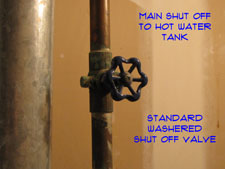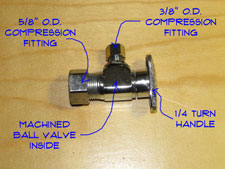 The type of water shut off valve that you have will determine what could be wrong with it and what methods you may have to employ to fix it. Leaks and a failure to turn off are the most common problems.
The type of water shut off valve that you have will determine what could be wrong with it and what methods you may have to employ to fix it. Leaks and a failure to turn off are the most common problems.
Do you have a different problem? See 'Plumbing Repair' for a complete listing of all the plumbing topics.
The function is the same for all of the valves. When they are open the water flows through. Closed, the water stops flowing. Bad seats or washers can cause this functionality to fail.
Ball Valves
The best and least problematic valves are lever ball valves. Generally you can recognize these by a straight lever instead of a round handle. The other main feature is that they only turn ninety degrees or one quarter turn. Instead of using a washer, these valves have a machined ball inside that positively shuts the water off. These valves are less likely to leak and give you problems over the long haul. However, the down side is that they cost a lot more and plumbers are not inclined to use them on new installations.
One quarter turn 'ball' type water shut off valves for residential fixtures have gotten popular in recent years and the cost has come down considerably. If you do need to replace a chrome shut off valve in your home, you should consider this type.
Gate Valves
Gate valves are not common in homes. Like the ball valve they have a machined inner mechanism. The 'gate' that moves down to shut off the water is controlled by a handle that turns similar to a normal valve. Gate valves are usually larger than a normal valve. This type also costs a lot more and is seldom used. They are more often found in commercial or industrial applications.
Washered Valves
Washered type water shut off valves are the ones you find most often. They come in different sizes and shapes but the general way they work is the same. The washer closes down on a metal seat via the handle and shuts the water off. The problem is that the washers wear out and don't shut off properly.
It is not uncommon to find jars full of various sized washers in garages and basements around the country. Washers come in numerous sizes. Replacing a washer with the wrong sized one will not have good results. Washered valves are the cheapest to purchase and they have the most problems.
Fixture Shut Off Valves
Most of you household fixtures, such as sinks and toilets have water shut off valves located near or below the fixture. Look under your kitchen sink and you will likely find two shut off valves located there.
 These valves are usually chrome plated and also act as a reducer in the pipe size. Often they reduce the 1/2" water lines to 3/8" lines that attach to the individual fixtures.
These valves are usually chrome plated and also act as a reducer in the pipe size. Often they reduce the 1/2" water lines to 3/8" lines that attach to the individual fixtures.
No matter which style you have you will need to shut the water off to work on the valve. Quarter turn ball valves are a much better choice if you decide to replace the valve. The shut off action is much more positive. In addition the machined ball is less prone to problems in the future.
To replace this valve remove the old one, (assuming you have a threaded or compression fitting) and install a new one. Use the old nut on the new comprssion valve, since it is unlikely that you have enough extra pipe cut off the brass ferrule. Use pipe dope on the threaded fittings. Pipe dope is not needed for a compression fitting.
Stuck with a soldered valve? You probably want to try replacing the washer and tightening the nuts on the valve. Soldering in an existing bathroom is not a great idea.
Outdoor Valves
Outdoor water shut off valves are modified forms of a washered valve. Frost free valves have a long rod on the handle that closes a washer deep inside the wall where freezing is eliminated.

